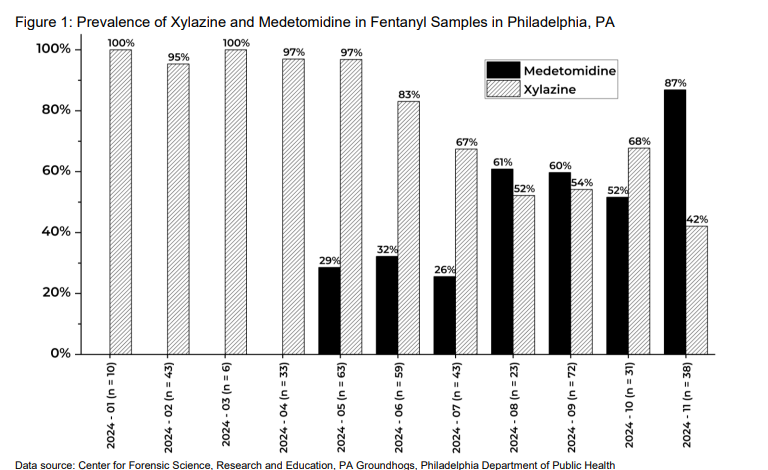Medetomidine, an animal sedative, appears to be replacing xylazine as a significant adulterant in fentanyl and perhaps other drugs. According to reports from Philadelphia, one of the areas where xylazine first gained prominence, medetomidine was in 87% of samples of fentanyl in November 2024 compared to just 42% of samples which contained xylazine, while at the beginning of the year xylazine was in 100% of the samples. Why is this happening? Pennsylvania rescheduled xylazine as a class III controlled substance in May of 2024, making it harder to obtain.

Drug dealers, who I believe mixed xylazine into fentanyl because it is so much cheaper than fentanyl, are simply moving on to the next similar substance. A Notes From the Field Report from the CDC says medetomidine like xylazine provides sedation, but unfortunately leads to even more severe withdrawal experiences than xylazine. On the other hand, it appears to not cause necrotizing wounds like xylazine does.
Sedative ‘dex’ is replacing ‘tranq’ in illegal drug supply and causing excruciating withdrawal
How this switch will affect fatal overdoses in uncertain. When xylazine showed up, people were scared that it would lead to increased fatalities, but it appears to have had a protective effect. Rather than adding xylazine on top of fentanyl, xylazine replaced some of the fentanyl thus each bag, containing less of the lethal drug, appears to have led to fewer overdoses. Additionally, by providing extended sedation (“legs”) people use less often, resulting in fewer opportunities to overdose. In Connecticut as xylazine rose in the drug supply, deaths went down.
I don’t have official numbers on how prevalent medetomidine is in Connecticut today, although I do know, according to the state health department, one of the fatalities in December 2024 tested positive for medetomidine, and early drug checking data shows increasing amounts beginning last year.
While fatal overdoses declined significantly in the last six months of 2024 in Connecticut, nonfatal appear to be increasing through each of the first four months of the year according to EMS data. No solid information yet on whether fatal overdoses are also up, although anecdotally, I believe they are. (Why they declined and why they may be going back up is open for speculation.)
Life xylazine, medetomidine, is not an opioid. It will not respond to naloxone. But it seems unlikely that either of these animal sedatives are stopping people from breathing on their own. If someone takes fentanyl with medetomidine and they stop breathing, naloxone, if given in time, should still restore their breathing, while it may not affect their sedation. Sedation is fine as long as they are breathing. We don’t care if the patient wakes up, we just want them to be able to breathe on their own. The sedation will eventually wear off.
What does this all mean? We have an everchanging drug supply as dealers try to make more money, utilizing the cheapest available chemicals, and evade crackdowns. We can only hope that the newer and next chemicals will be less toxic, but that thinking is clearly wishful.
